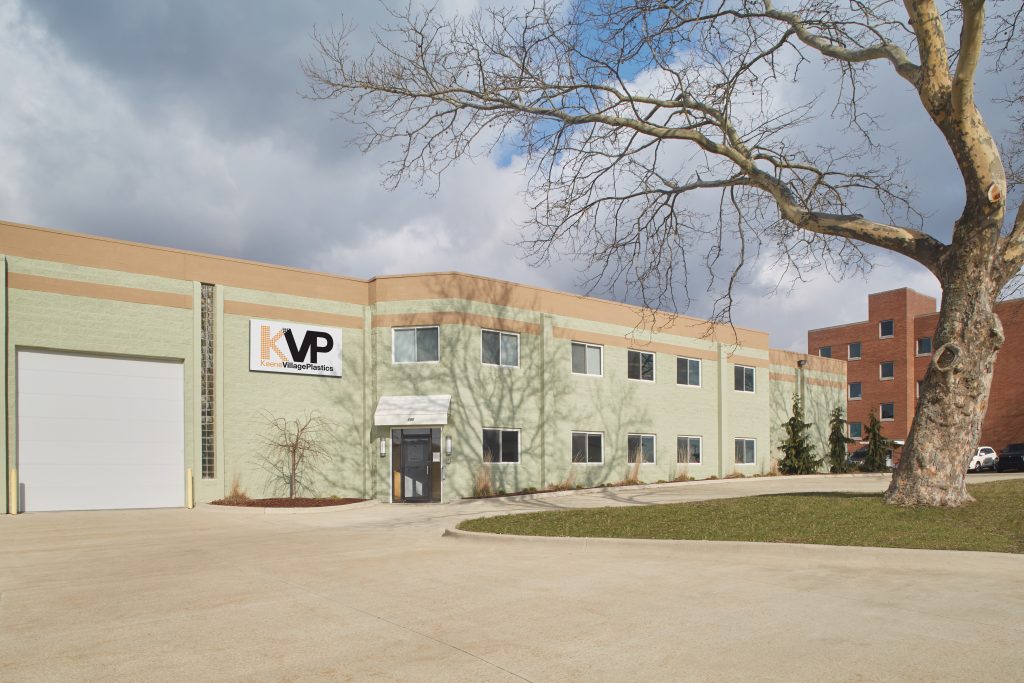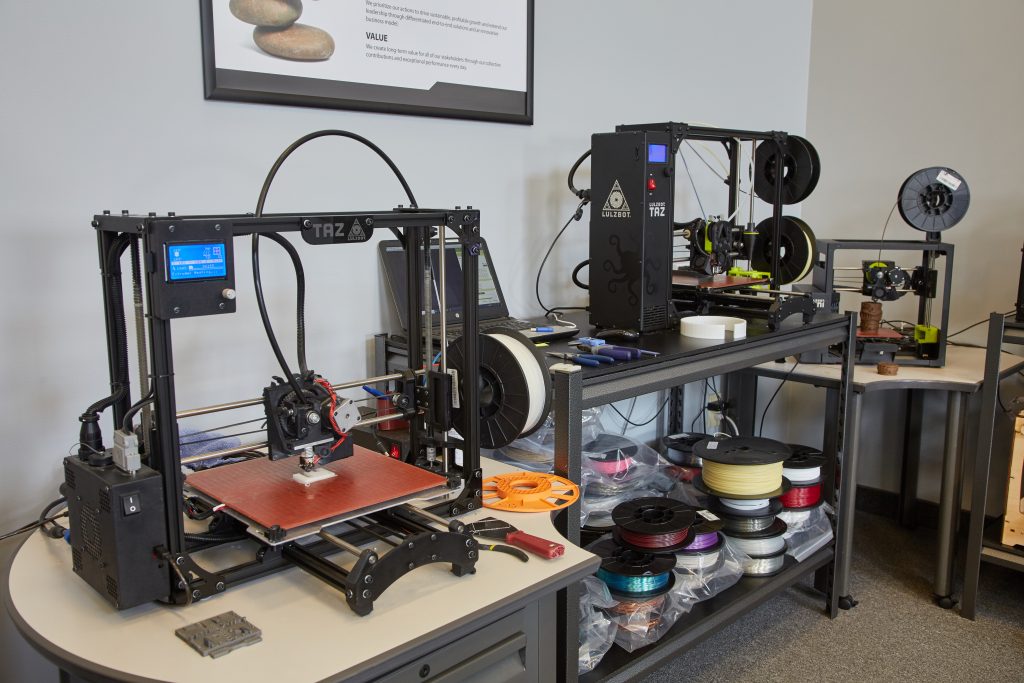
At 3DPrint.com we’re trying to give you a good look inside the things that matter in the 3D printing industry. We’re now actively looking at interviewing people from all over the world engaged in the industry to see what their thoughts are about the 3D printing present and future. We want to tell the stories of the people and the companies involved in our industry. Today we interviewed John Hosbach the Plant Manager of Village Plastics. Village Plastics is one of the world’s largest filament manufacturers. Based in Barberton, Ohio the company started as a welding rod manufacturer before in the mid 2000’s focusing on filament. This is actually a path than many filament companies took towards the market because the products are similar (although quality is not). Village then was acquired by 3D Systems and served as their internal filament development and prodution division before being sold in 2017 to Keene Building Products where it is now Keene Village Plastics. Keene is an important player in the OEM and white label space but virtually unknown to many in the industry so we thought it important to interview them. We spoke to John to see what it is like being in the filament business now and about the development of the firm.

How did you get started in 3D printing filament production?
We started in 2004, making welding rod for the plastic fabrication market. Makerbot called, asking if we could produce a smaller diameter in a different material, to which we said yes. Figured it out, and started supplying MakerBot with their filaments, running PLA, ABS and another material for them. We then started supplying most of the industry, including 3DSystems, at the time with materials.

What are your tolerances on roundness and dimension?
We publish .003 for both dimension and ovality. In actuality, we are much tighter and closer to the 0.0019. We see more of the filament than most manufacturers because of our 3 Axis Laser system and the fact that we don’t master spool, so our line speeds are slow enough that we have more data points than most people, ensuring quality filament, all the time. Our PPK numbers are well over 3, and our CPK numbers are as well.
How did you manage to find growth in this business?
We grew with the industry, by being able to scale with demand, deliver a superior quality product on time, and being agile enough to work with the customers ever changing requirements. We currently have 15 extrusion lines in 30,000 square foot of space with includes manufacturing and warehousing.

So you were a 3D Systems unit?
We were purchased in 2013 by 3DSytems and were considered a strategic asset for the company. We could service existing customers/accounts, but had no growth plan for pursuing new outside business. We did some material development, but all for 3Dsystems and their Cube line of printers. Most of the industry didn’t want to deal with a larger corporation at the time, and MakerBot (being purchased by Stratasys) took business elsewhere. Many issues with the Cube line of printers, and engineers were put on other projects, so that line was obsoleted, and we were scheduled to close. We did end up with several offers on the business.
Whose now behind the firm?
Keene Building Products is who purchased us. They do some extrusion into an entangled mat product used in the building industry, and our expertise with a wide range of materials was an attractive component to their growth, as well as ours.
What are key differentiators that filament companies need?
Capacity, innovation, quality, stability and the ability to service the customer in a reasonable amount of time are all important differentiators. The other is to be accessible and responsive to requests or questions, and then deliver on what you promised.
What kinds of new products are being developed?
We always have materials in development or trials of new materials going on. These could be internally driven, customer driven, or driven by material manufactures that have something unique that they want to bring to market.
Why do white label customers work with you?
We are scalable, meaning we can easily allocate production time to accommodate their growth. We can share our quality data for each individual spool, not just a batch. We keep that data for 5+ years. We can create COA reports as well, so they have complete traceability of their orders. We are also accessible, so we develop relationships that go beyond a customer and vendor relationship.
What kinds of new grades of materials do you want to have?
Our focus on materials is on engineered materials right now. Functional materials to be utilized in the industrial and manufacturing industries. We have a large material offering on the consumer side, so we will continue to add colors to that existing line. We do have some materials that are exclusive to us with our 3D-Solve material and our Performance rPET material.
Would you prefer a Dupont, Sabic or DSM email address?
We’ve had a 3Dsystems email address, so not sure if I’d want another large one. Each opportunity could be interesting though, so we are always willing to listen.
Companies in filament tend to compete on scale or versatility or innovation. What do you do?
I think we have all three: 15 extrusion lines (over 1,000,000 pounds or 450,000 kilos in annual capacity), with that capacity we are very agile and quick to react to customer requests and we are constantly working internally or with outside customers on new materials or products to bring to market. Our PAPC material is a perfect example of starting with an idea, working with FibreTuff on tweaking and perfecting the compound and creating a unique filament for medical applications.
What kinds of customers are your ideal customers?
Our ideal customers are repeat customers, those that understand that there is a difference in buying quality materials over buying something that is considerably cheaper.

I think that printability is just a lie and its just OEMs wanting problems with their 3D printers masked through polymer science and additives. Would you agree or disagree with this?
This is a really interesting concept, and I know that we have had to engineer some material differently to accommodate engineering deficiencies on certain printers in the past. However, I think being able to work hand in hand with the printer manufactures is what needs to happen. For example, if customers are requesting a certain type of material from Printer company A, that no one has, then let’s work together to see how we can make that material work in their machine. Collaboration is key!!
There is a lot of interest by large chemical and polymer companies in 3D printing, will they swallow us all?
I don’t think so, they are still learning about the industry, they want to be a part of it, but at least for now, would rather partner or work with a filament manufacturer than to swallow them up. That may change, as they learn and the market continues to grow.
What materials do you see as the future of 3DP?
Engineering grade materials that will really be disruptive to current manufacturing processes.
Whats your biggest competitive threat?
Currently it is branding and not having everyone aware of who we are, our history and what our capabilities are. We were part of 3Dsystems for 4 years, and in that time, manufacturers or distribution people have done a fantastic job with branding their lines.
We have lots of really low-quality filament and a few high-quality suppliers that are high priced. What type are you?
We are definitely high quality, and in the mid-range to high price point.
Subscribe to Our Email Newsletter
Stay up-to-date on all the latest news from the 3D printing industry and receive information and offers from third party vendors.
Print Services
Upload your 3D Models and get them printed quickly and efficiently.
You May Also Like
Metal Powder Supplier Elementum 3D Added to $46B Air Force Contract
Elementum 3D, a Colorado-based developer and supplier of metal powders used in additive manufacturing (AM), announced that the company has been added to the vendors list in the fourth on-ramp...
Ursa Major Lands $28.6M AFRL Deal for 3D Printed Draper Engine Flight Demo
The US Air Force Research Laboratory’s (AFRL’s) Rocket Propulsion Division at Edwards Air Force Base has awarded a $28.6 million contract to Ursa Major for follow-on work related to the...
3D Printing Financials: Rocket Lab’s Record-Breaking Year and Over 20 Launches Coming in 2025
Rocket Lab (Nasdaq: RKLB) closed 2024 with its best year yet. The company launched more rockets, signed more contracts, and expanded deeper into spacecraft and satellite production than ever before....
US Air Force Taps Beehive to Study 3D Printed Jet Engines
Propulsion 3D printing firm Beehive Industries secured a contract from the U.S. Air Force Life Cycle Management Center through SOSSEC. SOSSEC is a company that manages Other Transactions Authority (OTA)...

































